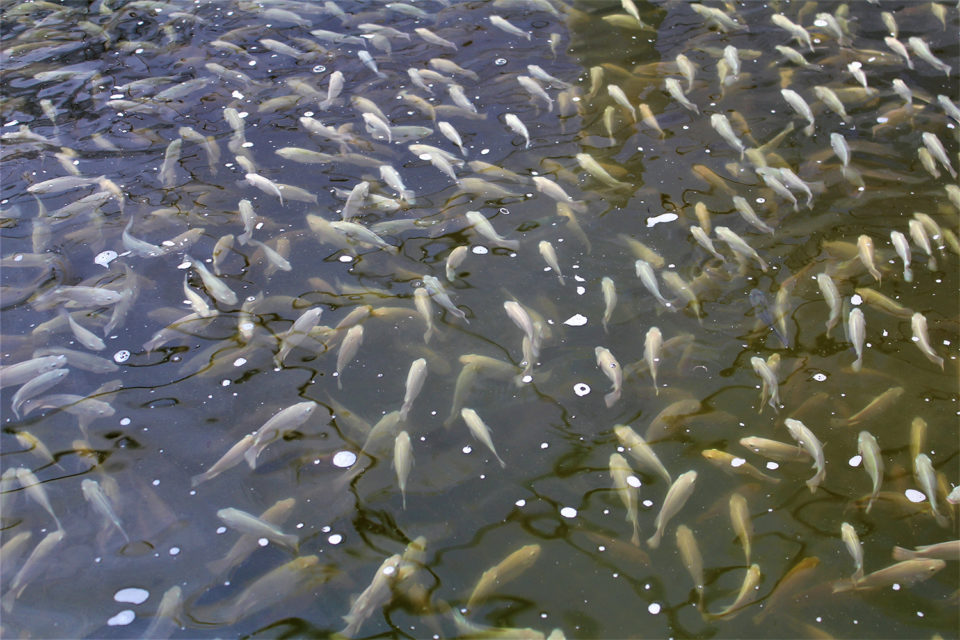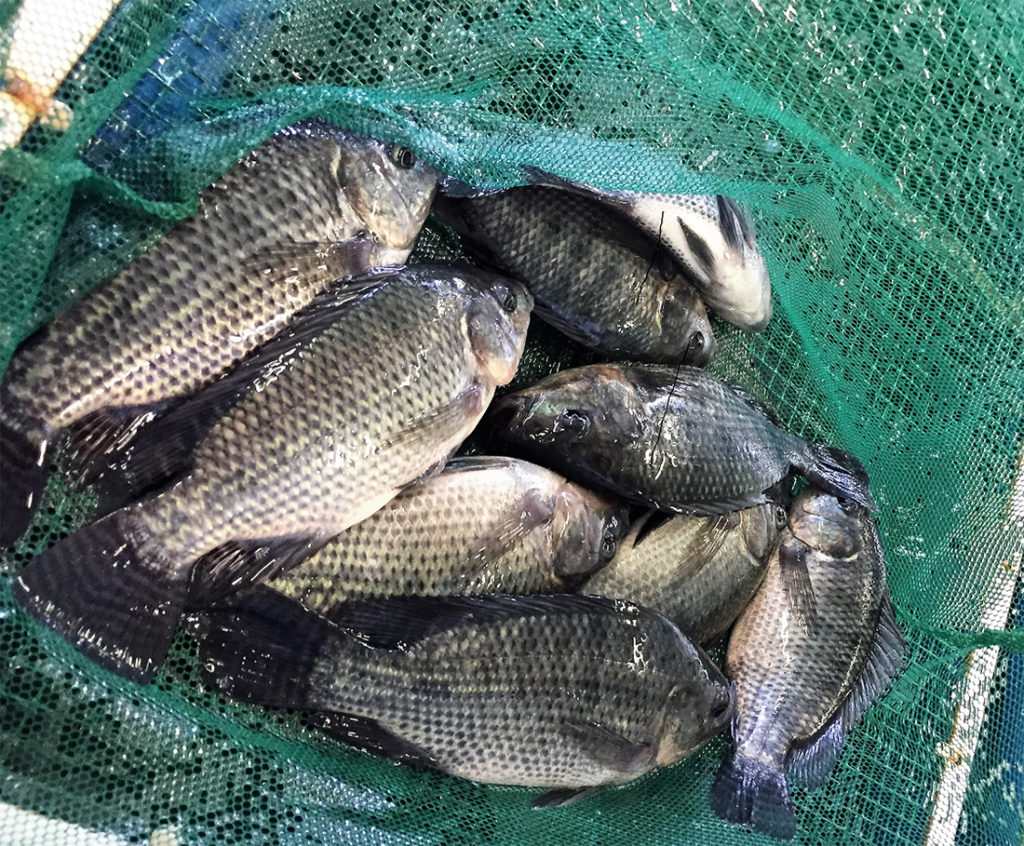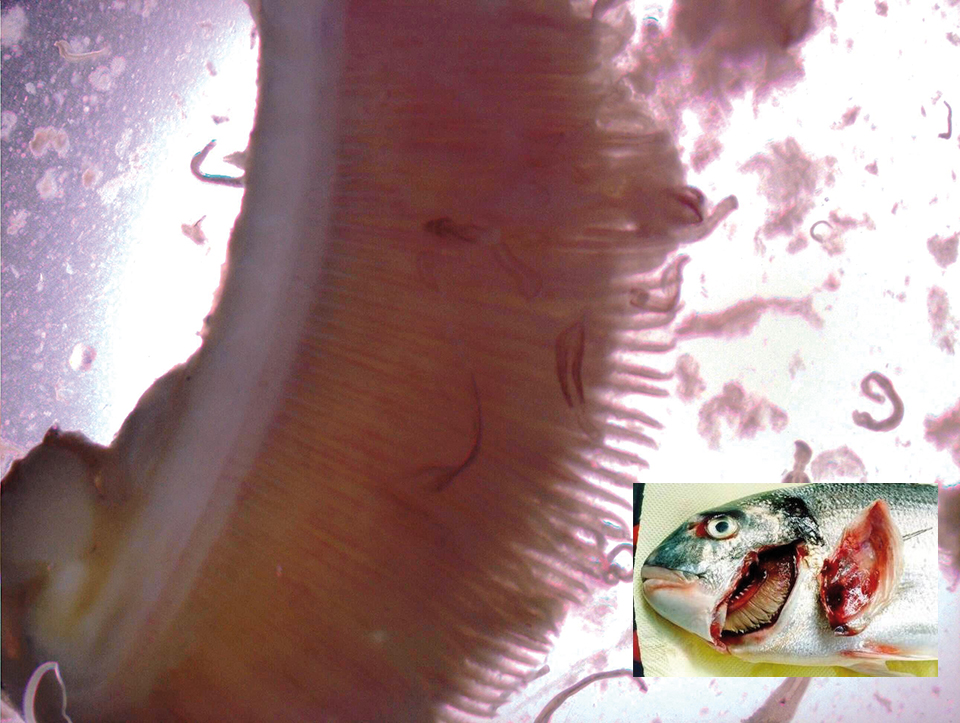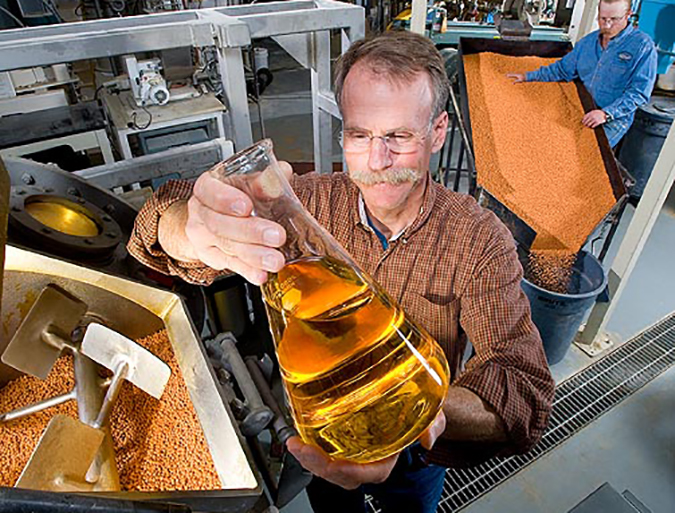Results showed that type of NSPs determines pond food web productivity

The current knowledge on nutrient requirements of fish is predominantly based on studies in which fish were kept in aquaria or cages. In these studies, the contribution of natural food to the fish production is minimal or absent. In ponds, which today are still the most common aquaculture production system, both diet composition and feeding level affect fish performance directly via digestion and absorption of the feed and indirectly via consumption of natural food, the latter stimulated by the feed waste acting as fertilizer.
Starch and free sugars are dietary carbohydrates, which can be hydrolyzed [chemical reaction with water to produce another substance] by fish enzymes and consequently absorbed. The remaining part of the carbohydrate fraction, the non-starch polysaccharides (NSPs), comprises (among others) lignin, cellulose, hemicellulose and pectins. NSPs are considered to have a low nutritional value for fish because of their low digestibility and also due to their anti-nutritional properties.
Knowledge on the direct effects of dietary NSPs on fish performance is relatively scarce. However, comparison within and between studies showed that the type of NSP can have different effects on fish performance, for example, hampering the digestibility of protein and fat. The effect of different types of dietary NSP on the fish production can be very different in ponds compared to their effects in RAS or cages. Unfortunately, information on the impact of the type of NSPs on fish performance in ponds including natural food, is not available.
This article – adapted and summarized from the original publication (Kabir, K.A. et al. 2020. Dietary non-starch polysaccharides influenced natural food web and fish production in semi-intensive pond culture of Nile tilapia. Aquaculture, Volume 528, 15 November 2020, 735506) – presents the results of a study to assess the effect of the type of dietary non-starch polysaccharides (NSPs) on the productivity of tilapia cultured in ponds, and determine if differences in types of dietary NSPs regarding fermentability (slow vs. quick) would affect pond productivity.
Study setup
Twelve, 30-square-meter, outdoor ponds, in a field experimental station in Bangladesh were used for this experiment, with each pond divided into three equal compartments. The fish used in the study were all male (average weight 90 grams), juvenile Nile tilapia (Oreochromis niloticus), 14th generation WorldFish GIFT, collected from the Asha Hatchery at Bagerha. Two diets, with different type of NSPs were fed to the fish for 56 days.
Two experimental diets were formulated – and extrusion processed to produce 3-mm diameter floating pellets at an R&D facility in Vietnam – to test the effect of non-protein energy sources on the performance of fish and on natural food in the pond. A mixture of carbohydrate sources was used to increase both the starch and non-starch polysaccharide content in the diets (i.e., a mixture of digestible and non-digestible carbohydrate sources): A “PecHem-Diet” with quick/easy bio-degradable (fermentable) NSPs versus a “LigCel-Diet” with slow bio-degradable NSPs.
Fish were harvested on day 57, 19 hours after the last feeding, to ensure that no pellet remained in the stomach, euthanized, measured and relevant samples collected for the various analyses.
For detailed information on the experimental design and procedures; fish, rearing and housing facilities; experimental diets; water quality monitoring; sampling and analyses of soil, water nutrients, plankton, benthos and total bacterial count; proximate composition of fish and feed; feces collection and preservation; analyses of stomach contents; and analytical procedures and calculations, refer to the original publication.
Results and discussion
The experimental results demonstrate that the type of dietary NSPs can influence pond productivity in tilapia monoculture. This impact on productivity seems to be related to the enhancement of the natural food in ponds fed with the “LigCel-Diet,” as differences were observed in the concentration of water chlorophyll-a [a specific form of the plant pigment chlorophyll, used in photosynthesis], benthos abundance and total count of soil bacteria, and natural food content in fish stomach.
With the “LigCel-Diet” biomass gain was higher (2,599 vs 2,192 grams per pond compartment) and feed conversion ratio (FCR) was significantly lower (1.4 vs 1.9) than with the “PecHem-Diet.” Diet had no effect on fish survival and specific growth rate, SGR [a measure of the number of cell divisions per unit time]. For both diets, increasing feeding level significantly increased biomass gain, fish survival, FCR and SGR. There was a significant interaction effect between diets and feeding level on FCR. Fish body composition was the same in both diets.
With the “LigCel-Diet,” the apparent digestibility coefficient, ADC [proportion of a food that is digested compared to what is absorbed] was significantly higher for crude protein, fat, phosphorus and calcium and significantly lower for ash compared to the other diet. Neither feeding level nor the interaction between diet and feeding level influenced the apparent digestibility coefficient (ADC) of any nutrient. Diet composition did not alter the organic matter (OM) composition of the feces. Results of the C and N stable isotopes [isotopes are variants of a particular chemical element which share the same number of protons but have different numbers of neutrons] analysis revealed that N gain in fish originated from both feed and natural food of the pond.
The differences in pond productivity between diets was not due to a different input of nutrients via feeding. Ponds were all fed the same amount of protein (nitrogen) based on the analyzed dietary crude protein content. Although the C:N ratio of both diets were almost equal, the energy (C input) given to ponds at the “PecHem-Diet” was slightly higher compared to ponds at the “LigCel-Diet” due to a small numerical difference in C:N ratio. The small difference in dietary C:N ratio between the experimental diets might have reduced the observed impact of type of dietary NSP in our study. Next to N, P input via the feed into the ponds was identical between diets.
To determine if the effects of the type of dietary NSP on pond productivity were due to differences in nutrient digestibility (ADC), the ADC of macro-nutrients were determined in fish kept in tanks without the presence of the natural food web. The measured ADC of macronutrients showed that diets were not only different regarding the type of NSP, but also regarding their digestibility. The observed differences in ADC between both diets in protein and fat are most likely due to the fact that diets were largely different regarding the ingredients that provided the dietary fat and crude protein.
The question still remains how different types of dietary NSP steer the natural food in the pond. Enhancement of the natural food in a pond by fertilization through feed supplementation depends, among others, on the amount and composition of both the uneaten feed and the produced feces by the fish. The C:N ratio of the nutrient input is considered to be a key factor for natural food enhancement in fish ponds. The C:N ratio in the feed (12.3 vs 10.8) were slightly different but in the feces this ratio was comparable (17.1 vs 17.5). Overall, organic matter composition of the feces was determined to be similar.
Natural food abundance in the pond increased over time for both diets. Chlorophyll-a was higher in the pond fed with “LigCel-Diet.” Fish gut content and calculated N gain indicated an enhanced contribution of natural food to fish growth in ponds fed with “LigCel-Diet.” In conclusion, the type of dietary NSP determines tilapia productivity in semi-intensive managed ponds by altering food web productivity.
Perspectives
Results of our study showed that the “LigCel-Diet” enhanced natural food and increased its contribution to fish growth in pond culture of tilapia, while both diets had comparable C:N ratios. Therefore, not only the amount of C contributing to the C:N ratio, but also the composition of carbon is important for food web enhancement. The current study showed that the type of dietary NSP determines pond food web productivity.
Now that you've reached the end of the article ...
… please consider supporting GSA’s mission to advance responsible seafood practices through education, advocacy and third-party assurances. The Advocate aims to document the evolution of responsible seafood practices and share the expansive knowledge of our vast network of contributors.
By becoming a Global Seafood Alliance member, you’re ensuring that all of the pre-competitive work we do through member benefits, resources and events can continue. Individual membership costs just $50 a year.
Not a GSA member? Join us.
Authors
-
K.A. Kabir, Ph.D.
Wageningen Institute of Animal Sciences, Aquaculture and Fisheries Group, Wageningen University and Research, Wageningen, the Netherlands; and Sustainable Aquaculture Program, WorldFish, Bangladesh
-
M.C.J. Verdegem, Ph.D.
Corresponding author
Wageningen Institute of Animal Sciences, Aquaculture and Fisheries Group, Wageningen University and Research, Wageningen, the Netherlands[108,110,46,114,117,119,64,109,101,103,101,100,114,101,118,46,99,114,97,109]
-
J.A.J. Verreth, Ph.D.
Wageningen Institute of Animal Sciences, Aquaculture and Fisheries Group, Wageningen University and Research, Wageningen, the Netherlands
-
M.J. Phillips, Ph.D.
WorldFish Head Quarters, Penang, Malaysia
-
J.W. Schrama, Ph.D.
Wageningen Institute of Animal Sciences, Aquaculture and Fisheries Group, Wageningen University and Research, Wageningen, the Netherlands
Tagged With
Related Posts

Aquafeeds
Towards sustainable aquafeeds: Evaluating fishmeal substitution
This study evaluated replacing fishmeal with a protein-rich and EPA-rich co-product of the marine microalga Nannochloropsis oculate in diets of Nile tilapia.

Health & Welfare
Effects of combining two exogenous carbohydrases on growth of Nile tilapia
This study evaluated the effects of a combination of two exogenous carbohydrases – xylanase and β-glucanase (XB) – to enhance growth performance Nile tilapia juveniles.

Aquafeeds
Microminerals are important feed components
Microminerals participate in a variety of biochemical processes and must be supplied in prepared diets to support optimal growth and production efficiency.

Aquafeeds
Aquaculture Exchange: Rick Barrows
After 14 years with the USDA’s Agricultural Research Service, Rick Barrows talks about the importance of finding ‘complete’ and commercially viable alternative sources of omega-3 fatty acids and continuing innovation in the aquafeed sector.


